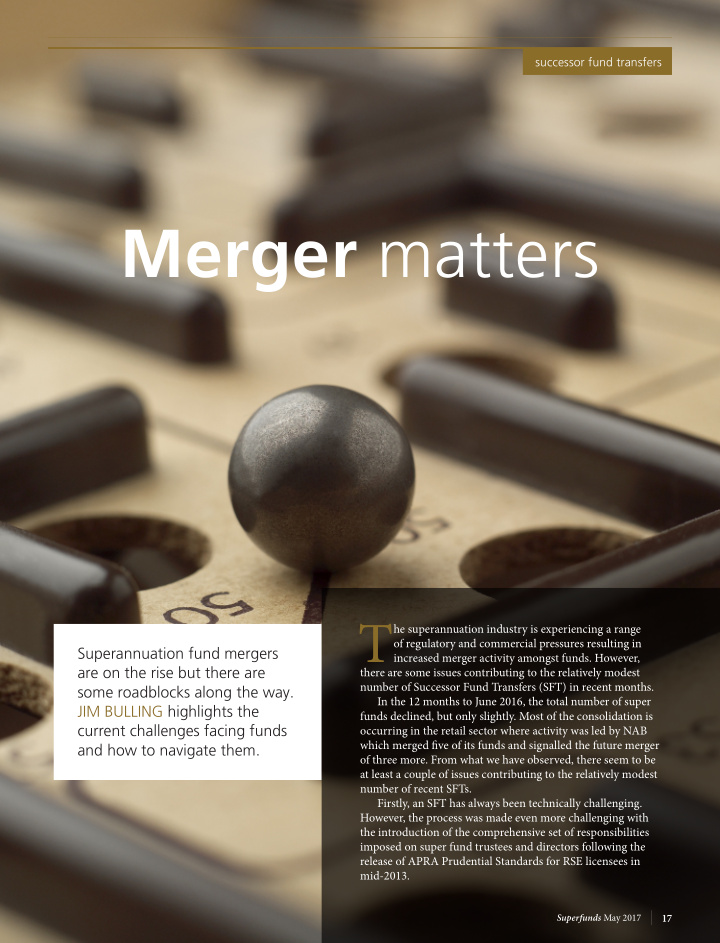



successor fund transfers Merger matters T he superannuation industry is experiencing a range of regulatory and commercial pressures resulting in Superannuation fund mergers increased merger activity amongst funds. However, are on the rise but there are there are some issues contributing to the relatively modest some roadblocks along the way. number of Successor Fund Transfers (SFT) in recent months. In the 12 months to June 2016, the total number of super JIM BULLING highlights the funds declined, but only slightly. Most of the consolidation is current challenges facing funds occurring in the retail sector where activity was led by NAB and how to navigate them. which merged fjve of its funds and signalled the future merger of three more. From what we have observed, there seem to be at least a couple of issues contributing to the relatively modest number of recent SFTs. Firstly, an SFT has always been technically challenging. However, the process was made even more challenging with the introduction of the comprehensive set of responsibilities imposed on super fund trustees and directors following the release of APRA Prudential Standards for RSE licensees in mid-2013. Superfunds May 2017 17
EQUIVALENT RIGHTS ANALYSIS (ERA) Perhaps in response to this, APRA down but should cover things such as: released Drafu SPG 227 – Successor • the existence and profjle of An SFT can only proceed if both the Fund Transfers and Wind Ups late respective MySuper and Choice transferring fund and the receiving last year which was the fjrst piece of ofgerings fund confer on the transferring guidance from APRA in relation to • the extent of respective outsourcing members equivalent rights. Tie SFTs since Superannuation Circular essential components of the conduct of • respective scale, market profjle and No I.C.4 was issued back in 2001. Drafu an ERA are examined in the existing fjnancial circumstances SPG 227 should provide RSE licensees and proposed APRA guidelines which • legal structure of target and acquirer with some confjdence on how to tackle include the following: • respective board composition the technical issues and should assist • the rights to be examined are • assessment of what will be required licensees to bring more focus to the legally enforceable rights, not to generate agreement. big picture possibilities of SFTs as a features which can be changed at HEADS OF AGREEMENT means of protecting the long-term best the discretion of the RSE licensee – interests of fund members. Assuming an agreement in principle for example, the list of investment A second issue which may have is reached to proceed with the options from time to time are not prevented some SFTs from being investigation of an SFT at the conclusion “rights” successfully prosecuted is the presence of preliminary due diligence, the parties • in making an assessment of of unresolved confmicts of interest. ought to then enter into a Heads of equivalent rights the RSE licensee is One example of such confmicts is Agreement which documents the expected to make the assessment on where trustee boards are comprised of understandings around the major issues. a bundle of rights basis rather than a directors representing a range of diverse Tie Heads of Agreement commits the line by line comparison of individual sponsors. In some instances, directors parties to the next stage without creating ‘rights’ have found it diffjcult to put the issues an unconditional obligation to complete • in practice, such an assessment of and interests of their sponsors to one the transaction. An appropriate Heads rights is based on groups of members side when examining the merits of an of Agreement would: with common characteristics rather SFT. Another example of confmicts arises • set out the major terms of the than on an individual basis. where cash or other consideration is transaction APRA has provided guidance on being ofgered to the target fund as part which features of the transferring and • identify the further steps that need of an SFT. receiving funds should be prioritised to be taken in order to be able for examination and many of these to execute binding transaction PRELIMINARY DUE DILIGENCE features are shared by conventional documents Whether a target fund is actually accumulation funds. Accordingly, • set out the process for the conduct required to consider an ofger from while some bespoke treatment for of the equivalent rights analysis and an acquirer fund depends on the insurance ofgerings is usually required, best interests analysis circumstances of both funds. A it is likely that in a proposed SFT from • set a timetable for the parties to prudent approach would be for the a conventional accumulation fund to undertake these steps. board of the target fund to at least another conventional accumulation At the conclusion of the activity conduct a preliminary due diligence fund, the RSE licensees will fjnd that contemplated under the Heads of on any proposed SFT. Tiis preliminary equivalent rights do exist. Agreement, the parties should be in investigation should fmesh out the critical a position to execute documentation MEMBER BEST INTERESTS issues and come to a view as to whether which commits them to completing the the proposal warrants the investment An SFT can only proceed if the transfer SFT. While difgerent circumstances will involved in proceeding further with is in the best interests of transferring determine the precise approach, the key detailed investigation. Tie level of members and the members of the documents which drive the completion preliminary due diligence ought to be receiving fund. Both boards will need to of the transaction are itemised as modest in the interests of keeping costs examine a host of factors should the SFT follows. 18 Superfunds May 2017
Recommend
More recommend